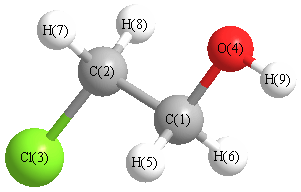Vibrational Frequencies calculated at CCSD(T)/cc-pVDZ
| Mode Number |
Symmetry |
Frequency
(cm-1) |
Scaled Frequency
(cm-1) |
IR Intensities
(km mol-1) |
Raman Act
(Å4/u) |
Dep P |
Dep U |
|---|
| 1 |
A' |
3838 |
3757 |
|
|
|
|
| 2 |
A' |
3105 |
3039 |
|
|
|
|
| 3 |
A' |
3012 |
2949 |
|
|
|
|
| 4 |
A' |
1522 |
1490 |
|
|
|
|
| 5 |
A' |
1491 |
1459 |
|
|
|
|
| 6 |
A' |
1463 |
1432 |
|
|
|
|
| 7 |
A' |
1306 |
1278 |
|
|
|
|
| 8 |
A' |
1239 |
1212 |
|
|
|
|
| 9 |
A' |
1098 |
1075 |
|
|
|
|
| 10 |
A' |
1044 |
1022 |
|
|
|
|
| 11 |
A' |
786 |
770 |
|
|
|
|
| 12 |
A' |
390 |
382 |
|
|
|
|
| 13 |
A' |
249 |
243 |
|
|
|
|
| 14 |
A" |
3174 |
3107 |
|
|
|
|
| 15 |
A" |
3057 |
2993 |
|
|
|
|
| 16 |
A" |
1297 |
1270 |
|
|
|
|
| 17 |
A" |
1207 |
1181 |
|
|
|
|
| 18 |
A" |
1059 |
1036 |
|
|
|
|
| 19 |
A" |
800 |
783 |
|
|
|
|
| 20 |
A" |
233 |
228 |
|
|
|
|
| 21 |
A" |
131 |
128 |
|
|
|
|
Unscaled Zero Point Vibrational Energy (zpe) 15750.0 cm
-1
Scaled (by 0.9788) Zero Point Vibrational Energy (zpe) 15416.1 cm
-1
See section
III.C.1 List or set vibrational scaling factors
to change the scale factors used here.
See section
III.C.2
Calculate a vibrational scaling factor for a given set of molecules
to determine the least squares best scaling factor.
